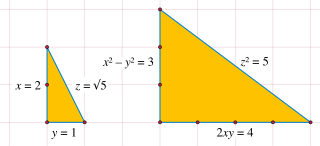Related Research Articles

A Pythagorean triple consists of three positive integers a, b, and c, such that a2 + b2 = c2. Such a triple is commonly written (a, b, c), a well-known example is (3, 4, 5). If (a, b, c) is a Pythagorean triple, then so is (ka, kb, kc) for any positive integer k. A triangle whose side lengths are a Pythagorean triple is a right triangle and called a Pythagorean triangle.

Goldbach's conjecture is one of the oldest and best-known unsolved problems in number theory and all of mathematics. It states that every even natural number greater than 2 is the sum of two prime numbers.

In number theory, a Gaussian integer is a complex number whose real and imaginary parts are both integers. The Gaussian integers, with ordinary addition and multiplication of complex numbers, form an integral domain, usually written as or
2 (two) is a number, numeral and digit. It is the natural number following 1 and preceding 3. It is the smallest and the only even prime number.

The Ulam spiral or prime spiral is a graphical depiction of the set of prime numbers, devised by mathematician Stanisław Ulam in 1963 and popularized in Martin Gardner's Mathematical Games column in Scientific American a short time later. It is constructed by writing the positive integers in a square spiral and specially marking the prime numbers.

In mathematics, parity is the property of an integer of whether it is even or odd. An integer is even if it is divisible by 2, and odd if it is not. For example, −4, 0, and 82 are even numbers, while −3, 5, 7, and 21 are odd numbers.

In mathematics, a square number or perfect square is an integer that is the square of an integer; in other words, it is the product of some integer with itself. For example, 9 is a square number, since it equals 32 and can be written as 3 × 3.

Lagrange's four-square theorem, also known as Bachet's conjecture, states that every natural number can be represented as a sum of four non-negative integer squares. That is, the squares form an additive basis of order four. where the four numbers are integers. For illustration, 3, 31, and 310 in several ways, can be represented as the sum of four squares as follows:
23 (twenty-three) is the natural number following 22 and preceding 24.
32 (thirty-two) is the natural number following 31 and preceding 33.
300 is the natural number following 299 and preceding 301.
127 is the natural number following 126 and preceding 128. It is also a prime number.
It is:
4000 is the natural number following 3999 and preceding 4001. It is a decagonal number.
In mathematics, the sieve of Atkin is a modern algorithm for finding all prime numbers up to a specified integer. Compared with the ancient sieve of Eratosthenes, which marks off multiples of primes, the sieve of Atkin does some preliminary work and then marks off multiples of squares of primes, thus achieving a better theoretical asymptotic complexity. It was created in 2003 by A. O. L. Atkin and Daniel J. Bernstein.
In number theory, a positive integer k is said to be an Erdős–Woods number if it has the following property: there exists a positive integer a such that in the sequence (a, a + 1, …, a + k) of consecutive integers, each of the elements has a non-trivial common factor with one of the endpoints. In other words, k is an Erdős–Woods number if there exists a positive integer a such that for each integer i between 0 and k, at least one of the greatest common divisors gcd(a, a + i) or gcd(a + i, a + k) is greater than 1.

A Pythagorean prime is a prime number of the form . Pythagorean primes are exactly the odd prime numbers that are the sum of two squares; this characterization is Fermat's theorem on sums of two squares.

In number theory, a polite number is a positive integer that can be written as the sum of two or more consecutive positive integers. A positive integer which is not polite is called impolite. The impolite numbers are exactly the powers of two, and the polite numbers are the natural numbers that are not powers of two.
In number theory, the numbers of the form x2 + xy + y2 for integer x, y are called the Löschian numbers. These numbers are named after August Lösch. They are the norms of the Eisenstein integers. They are a set of whole numbers, including zero, and having prime factorization in which all primes congruent to 2 mod 3 have even powers.
References
- Neil Sloane, A Handbook of Integer Sequences , Academic Press, NY, 1973.